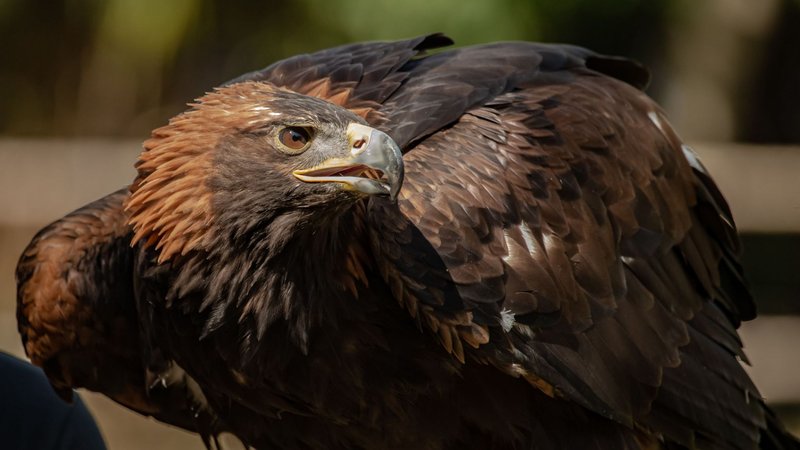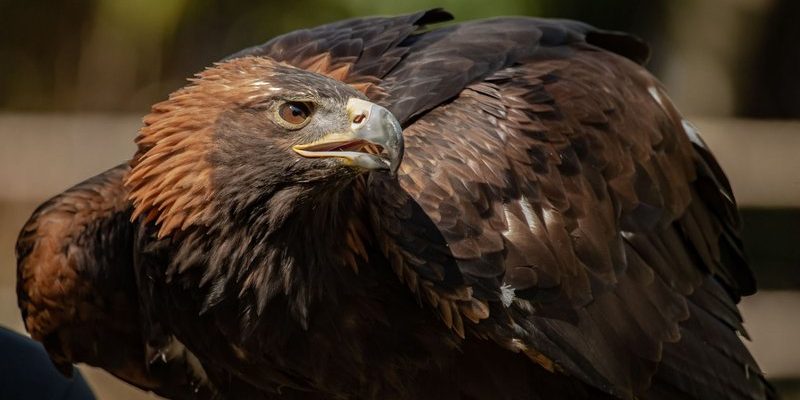
Golden eagles are found across the Northern Hemisphere, from North America to Europe and Asia. They are known for their unique hunting skills and adaptability, thriving in a variety of habitats, including mountains, grasslands, and even some urban areas. So, if you’ve ever wondered what makes these eagles top predators, here are ten fascinating facts that will give you a deeper appreciation for them.
1. Stunning Wingspan
One of the first things you notice about golden eagles is their impressive wingspan. These birds can have wings that stretch 6 to 7.5 feet across! Just imagine a bird that big soaring overhead. It’s like seeing a small airplane gliding in the air. The broad wings help them effortlessly ride thermal updrafts, allowing them to fly for hours without flapping their wings much.
This strong wingspan is not just for show, though. It helps in their hunting strategy. Golden eagles can dive at speeds of up to 150 miles per hour when they spot prey from high above. Their ability to efficiently use air currents also means they can cover great distances while searching for food.
2. Incredible Vision
Golden eagles boast some of the best eyesight in the animal kingdom. Imagine having vision that’s 8 times sharper than that of humans! They can spot a rabbit from over a mile away. This incredible eyesight is key to their hunting success, as it allows them to identify potential meals from great heights.
Their large eyes have adaptations that give them this superhuman ability. For instance, they have a high concentration of light-sensitive cells called cones. This helps them see both in bright sunlight and during low light conditions. Honestly, when they’re hunting, they’re like having your own personal night vision goggles, enabling them to detect movement and color details that we could only dream of seeing.
3. Masterful Hunters
Golden eagles are top-notch predators, renowned for their hunting prowess. They often hunt alone or in pairs, targeting small mammals like rabbits, hares, and ground squirrels. But that’s not all—they’re also known to take down larger animals, such as foxes or even small deer when the opportunity arises.
What makes them such effective hunters is their keen strategy. They prefer to surprise their prey by diving from above, using their speed and agility to catch them off guard. Here’s the thing: they also employ a “sit and wait” technique, where they remain still and scan the ground for movement. Once they spot something, they spring into action, diving down at lightning speed. It’s like the ultimate game of hide-and-seek.
4. Unique Nesting Habits
When it comes to nesting, golden eagles have their own unique approach. They typically build their nests, known as eyries, on high cliffs or in tall trees. These nests can be impressively large, with some measuring up to 6 feet across and weighing several hundred pounds!
What’s interesting is that they often reuse the same nest year after year, adding new materials each time. This means a nest can become a massive structure over the years. You might be wondering what goes into these nests. The eagles use sticks, grass, and even animal bones to create a sturdy home. There’s a kind of charm in knowing that every nest holds a story and a legacy.
5. Strong Family Bonds
Golden eagles are not just fierce hunters; they’re also devoted parents. After mating, the female lays one to four eggs, and both parents take turns incubating them for about 45 days. Once the chicks hatch, they’re dependent on their parents for food and protection.
The bond between the parents is strong, and they often work together to hunt for their young. As the chicks grow, they begin to exercise their wings and learn to fly. Here’s the thing: even after the young eagles fledge, they stay close to their parents for several months, learning skills they’ll need to survive on their own. This nurturing phase is crucial for their development and survival in the wild.
6. Diverse Habitat
Golden eagles are incredibly adaptable and can thrive in various habitats. From rugged mountains and open grasslands to even deserts and tundras, these birds have found a way to call many places home. This adaptability is essential for their survival, especially as they face changing climates and human developments.
Their preference for open spaces allows them to spot potential prey from afar, but they also need places to perch and nest, hence the cliffs and tall trees. It’s fascinating to think about how these majestic birds can adjust to different environments while still maintaining their hunting skills and nesting habits.
7. Cultural Significance
Throughout history, golden eagles have held a special place in various cultures. For many Native American tribes, they symbolize strength, courage, and freedom. Their feathers are often used in traditional ceremonies, and spotting one is considered a good omen.
In ancient civilizations, like the Romans, golden eagles represented power and were even associated with gods. It’s intriguing to see how these birds have inspired art, folklore, and spirituality across different cultures. They’re not just birds; they’re deeply woven into the tapestry of human history.
8. Conservation Status
Despite their strength and adaptability, golden eagles face threats from habitat loss, poisoning, and hunting. While they’re not endangered, conservation efforts are crucial to ensuring their populations remain stable. Organizations work tirelessly to monitor these majestic birds and protect their habitats.
You might wonder how you can help. Supporting wildlife conservation initiatives and spreading awareness about the importance of preserving natural habitats can make a difference. Every bit counts when it comes to protecting these magnificent creatures and their ecosystems.
9. Unique Behavior
Golden eagles are known for some truly fascinating behaviors. For instance, they often perform aerial displays, especially during courtship. These displays include swooping, diving, and even tumbling mid-air. It’s a breathtaking sight, almost like a dance in the sky!
They also exhibit territorial behaviors, where they mark their territory by soaring high and making loud calls to warn off intruders. It’s not just about protecting their space; it’s also an impressive display of their power and dominance in the area.
10. Long Lifespan
Golden eagles have a relatively long lifespan compared to other birds of prey. In the wild, they can live up to around 20 years, and some have even been known to reach over 30 years in captivity. This longevity is partly due to their position as top predators, which allows them to avoid many of the dangers smaller birds face.
Their long lives mean they can have many breeding seasons, contributing to their success as a species. It’s amazing to think about how each golden eagle carries the wisdom of years spent mastering the skies and hunting strategies.
As you can see, golden eagles are more than just stunning animals—they’re fascinating creatures with unique traits and behaviors. From their powerful hunting skills to their cultural significance, these birds continue to captivate our imaginations. So, the next time you catch a glimpse of one soaring through the sky, remember just how special it really is.

